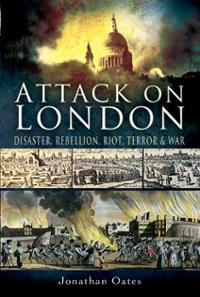
Jonathan Oates. Attack on London: Disaster, Rebellion, Riot, Terror and War. Barnsley: Wharncliffe Local History, 2009. RRP £19.99.
Out of all the high street chains of bookstores, I have a particular fondness for The Works. If you’ve never come across one before, it’s a sort of outlet store for books and stationary, and I can rarely resist having a browse when I walk past one. I have found numerous bargains in there over the years, including Attack on London by Jonathan Oates.
Dr. Jonathan Oates is the Ealing Borough Archivist and Local History Librarian, but he has also published numerous books on London’s history, particularly its more criminal elements. In Attack on London Oates, inspired by the 7/7 bombings, traces how Londoners have reacted to tragedy, shock, and trauma. Starting with the Peasant’s Revolt in 1381, Oates documents some of the most severe hardships faced by London, including the Great Plague (1665-1666), the Gordon Riots (1780), the Clerkenwell Outrage (1867), Bloody Sunday (1887), aerial bombing during both World Wars, IRA bombings during the 1970s, and the 7/7 bombings in 2005. Oates concludes by arguing that such dramatic events bring out both the best and the worst of Londoners; there has been resilience, bravery, and unity, but also looting and xenophobia.
If you are familiar with London’s history, then there probably isn’t much in Attack on London that will be new to you, although I was surprised to learn about the extent of aerial bombing on the capital during the First World War. However, the way the which Londoners reacted to these well-known events is a new angle, which brings together disparate events such as riot, war, disease, and fire in an interesting way. Oates’ referencing style is not very detailed, so it is difficult to identify the exact sources of his work, but it seems to be a well-researched book.
There are some elements of Attack on London that feel a little ‘amateur’. For example, each chapter ends with a conclusion identified as such with a subheading. This feels a little out of place in a history book aimed at a popular audience. Also, one of the photos reproduced in the book, of a plaque commemorating the deaths of 77 people in an air raid bombing in Southwark in October 1940, is blurry. I know I’m being picky, but little things like these combine to give a general impression of not-quite-finishedness that could have been so easily avoided. In addition, the book commits one of my biggest personal faux pas; putting all of the images on a few glossy pages in the middle of the book, and not referring to them in the main text. I know that lots of books have their images arranged in such a way, I guess it is an effective or cost-efficient way of illustrating books. I can understand that, although I would prefer to have the images close to the relevant text. However, when the author does not refer to the images in the text, then they become almost pointless, as they do not serve to back up or illustrate a particular point. Attack on London is by no means the only book that does this, but it winds me up nonetheless.
Because I found Attack on London in a bargain bookshop, it cost me quite a bit less than the £19.99 recommended retail price, which is a bit steep, in my opinion, for what you get. Nevertheless, it is an easy-to-read, engaging reflection on the best and the worst facets of Londoners.